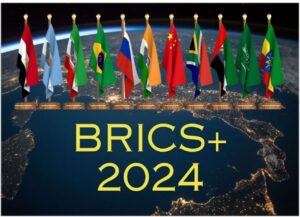BRICS, an acronym for Brazil, Russia, India, China, and South Africa, represents a coalition of emerging economies that sought to influence global economic policies and create alternatives to Western-dominated financial structures. This article explores the origins, evolution, objectives, and current standing of BRICS, providing a comprehensive understanding of its significance and challenges.
1. BRICS:
BRICS was originally coined by Jim O’Neill, a former Goldman Sachs economist, to represent the powerful emerging economies of Brazil, Russia, India, and China. These nations were initially grouped based on their rapid economic growth and potential to reshape global economic landscapes. In 2010, South Africa joined the coalition, turning BRIC into BRICS. Today, the BRICS group holds a significant share of the world’s population and economy, positioning itself as a voice for developing nations on the global stage.
2. Background:
The idea of BRICS evolved from a series of informal meetings between Russia, India, and China in the early 2000s, aiming to discuss economic collaboration and mutual interests. These early discussions culminated in the formalization of BRICS as a cooperative entity in 2009. The group’s first summit was held in Yekaterinburg, Russia, marking the beginning of BRICS as a formal international alliance. South Africa’s addition in 2010 expanded the group’s geographical representation, making it a truly cross-continental entity.
The expansion has continued, with recent additions of Egypt, Ethiopia, Iran, and the UAE in January 2024. Other countries, such as Saudi Arabia, have also shown interest, illustrating BRICS’s appeal as a platform for countries seeking alternatives to Western-led institutions.
3. Key Objectives and Goals:
BRICS was formed with several objectives:
– Economic Cooperation: BRICS countries aim to reduce their dependency on Western financial institutions like the International Monetary Fund (IMF) and the World Bank. This goal is embodied in initiatives like the New Development Bank (NDB), which provides funding for infrastructure and development projects within BRICS and other emerging economies.
– Financial Independence: BRICS has explored ways to decrease reliance on the U.S. dollar by promoting trade in local currencies and discussing the feasibility of a shared currency.
– Political and Diplomatic Influence: BRICS advocates for a multipolar world and challenges the dominance of Western powers in global governance, seeking a more balanced international order.
4. Notable Initiatives and Institutions:
– New Development Bank (NDB): Established in 2014 in Fortaleza, Brazil, the NDB aims to fund infrastructure and sustainable development projects. It was created as an alternative to the IMF and World Bank, focusing on financing without the political conditions often attached to Western loans.
– BRICS Rating Agency: To provide member countries with a fairer assessment of creditworthiness, the idea of a BRICS-centric rating agency has been explored as an alternative to Western agencies like Moody’s and S&P.
– BRICS+: The recent expansion efforts under BRICS+, including the addition of new countries, aim to bolster the group’s influence by including nations aligned with BRICS’ vision of a multipolar world.
5. Challenges and Criticisms of BRICS:
Despite its ambitions, BRICS has encountered numerous obstacles:
– Internal Disparities: The economies within BRICS vary greatly, from China’s vast economic power to South Africa’s more limited resources, creating an imbalance that complicates cohesive economic policies.
– Geopolitical Tensions: Relationships among members, particularly between India and China, have been strained due to border disputes and other regional rivalries, hindering the group’s effectiveness.
– Limitations of the NDB: Although the NDB has approved several projects, actual loan disbursements have been low, leading to critiques about governance and effectiveness.
6. BRICS in the Contemporary World:
BRICS is evolving, though its growth has been inconsistent. Its goals of de-dollarization, greater economic independence, and establishing a unique stance in international diplomacy remain central. As the alliance seeks to expand and strengthen, it must navigate both its internal differences and the complexities of an increasingly multipolar world.
In conclusion, while BRICS has achieved some milestones, it has not fully realized its potential as a counterweight to Western dominance. Its success in the coming years will depend on its ability to unify its members’ economic and political objectives, adapt to global shifts, and address criticisms related to governance and effectiveness.
